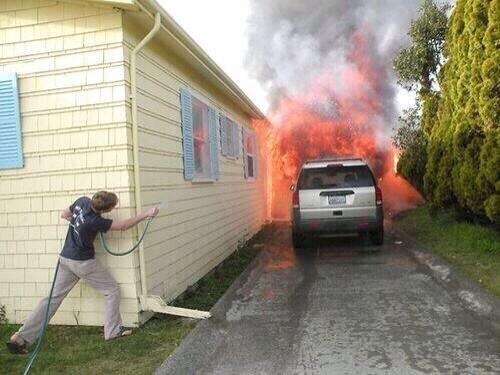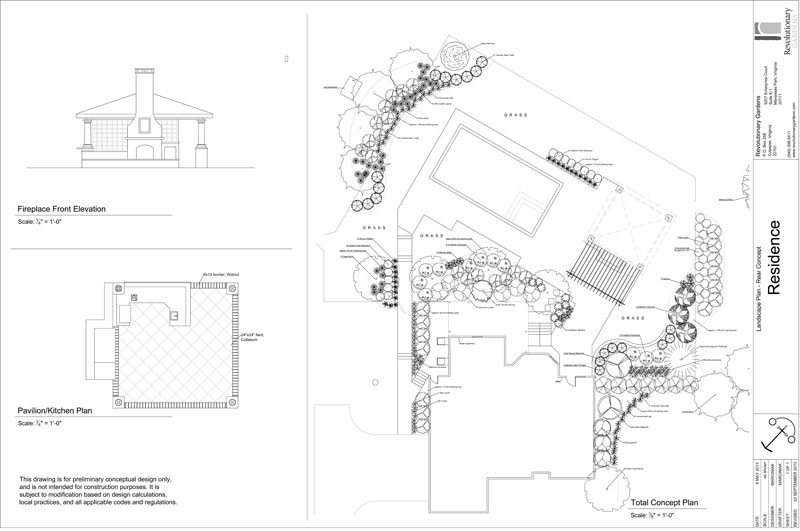From time to time I like to stick my head in various online forums where homeowners look for landscape advice. It’s definitely not an unusual occurrence for someone to create a post complaining about their contractor and asking for help. In some cases they’re just in way too deep and any advice short of “talk to your lawyer and see how hosed you are” feels like this:

Sadly, a lot of these problems can be hammered out on the front side, when you’re still working out the details and before you’ve signed that contract. FACT: Most contractors you’re going to meet are really good people who just want to do a great job and get paid fairly. We hear about the horrible, awful, scary cases but most contractor-homeowner disputes arise (in my opinion) because everyone wasn’t on the same page! Several years ago I wrote a post about some of the dumber myths surrounding hiring a landscape contractor; here’s some advice for you to use in the hiring process:
1. Get a design
I mean an actual plan, not just a couple of chicken scratches on a piece of graph paper covered in coffee cup rings and “I’m on hold” doodles. Yes, you may have to pay for that. Yes, it may even mean hiring a designer and then bringing the drawing back to the contractor. A detailed landscape plan helps remove uncertainty, ambiguity, and gray areas from the sales and construction process. Here’s an example of a landscape plan:
As you can see there’s not much opportunity for anyone to be confused about sizes, quantities, and finishes, right? Trust me, a master plan is the best place to start for any project much bigger than a simple planting (and even then it can be really useful having a plan drawing. It seems like every time I’ve winged it, it’s come back and bitten me).
2. Get a detailed contract
I’m not saying to insist on a line item contract because that can be onerous for the person doing the estimating, and a lot of contractors view that request as a red flag signalling a difficult client who will nickel and dime them on everything (in my experience that’s often the case). Rather, what I’m saying is this is unacceptable to me:
Install patio, walk, and plantings. $14,000
Rather, this is what I like to see:
Contractor agrees to furnish and install the materials to construct a new paver patio on aggregate base per manufacturer specs. Pavers are to be Eagle Bay Brikstone in Jefferson color, approximately 350 sq ft. Cost: $5,250
Contractor agrees to furnish and install the materials to construct a new paver front walk on aggregate base per manufacturer specs. Pavers are to be Eagle Bay Brikstone in Jefferson color, approximately 200 sq ft. Cost: $3,000
See the difference? For the plantings, I like to know what plants and what sizes are going to be installed. “Plantings” as a line item doesn’t work for me. A list of everything – ie, “(1) October Glory maple, 3″ caliper; (7) Skip Laurel, 4-5 ft” – does work for me, with a total cost at the bottom. Again, we want to remove ambiguity. It protects all parties. You know what you’re paying for, and the contractor knows that you understand when he’s satisfied the conditions for the next draw payment. Which leads me to…
3. Establish a payment schedule
Another complaint I’ve heard is “my contractor keeps wanting more money to finish the job.” From the other side of the table I’ve heard “I need more money for materials and the homeowner won’t write me a check.” A payment or draw schedule makes these issues go away. Generally I expect a draw schedule to have the amount required to hold your spot on the schedule, the amount required to get started, and then periodic draws throughout the project based on milestones, with usually one small amount (5-10%) left until final walkthrough. These milestones are usually pretty clear cut: completion of demolition, completion of patio, etc.
4. Establish a communication procedure
This falls more on the contractor than the homeowner but if nothing is discussed, it’s worth asking about. If you have a question about something during the install, who do you talk to? The installer? The project manager? The sales person? Every company does things a little differently and it’s important to know who has the authority to a) answer your questions and b) make decisions to resolve those questions. If you ask the wrong person to make a change and there’s no procedure in place, it can lead us to…
5. Insist on change orders for every change
Some contractors know their margins enough that they may just go ahead and do a small change with no additional charge, but how will you know unless you ask? One of my clients used a carpenter (no one from my Rolodex) and throughout the project she made numerous changes. Every request was met with a shrug and “sure, we can do that.” At the end of the job she was handed a bill for the contract amount plus change order amounts. It didn’t exactly lead to her eating ramen for a month, but it was a shock at the end of an otherwise really pleasant project. Clearly she and her contractor weren’t on the same page. Don’t let this be you!
Those are some pretty basic tips that many people just don’t seem to do. Do your research, follow my advice, and listen to your gut and you should have a great install!



Leave a Reply